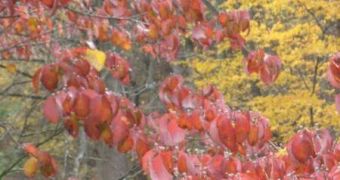While European poets and writers have for centuries written about the beauty of the yellow canopies in autumn, their American and Asian counterparts have mostly described the foliages as having a reddish hint to them. The difference is still visible today, and botanists set out to investigate precisely why that is so. According to newly published studies, it would appear that the answer can be traced back to more than 35 million years ago, ScienceDaily informs.
An international team of scientists, led by University of Haifa-Oranim Department of Science Education and Biology professor Simcha Lev-Yadun, and University of Kuopio professor Jarmo Holopainen, from Finland, suggests that the amount of chlorophyll pigment in the leaves is the source of the discrepancy, and that the moment of separation between the American/Asian and the European varieties occurred more than 35 million years ago. Details of their investigation appear in the in the latest issue of the Journal New Phytologist.
The colors that appear in the leaves when autumn comes are not, contrary to popular beliefs, due to the fact that the leaves are dying. In the case of yellow leaves, this simple process occurs – as the amount of chlorophyll is diminished, the green pigment no longer retains “supremacy” over all other pigments in the leaf. The yellow ones are next to chlorophyll in terms of saturation, and so they become the most visible. The situation is however a bit different in the case of red foliages.
The main difference is that, in red leaves, the red pigments are not already in the leaf when chlorophyll disappears. Rather, this reduction in the green pigment is a trigger for a series of chemical reactions, which in the end produce the reddish coloration. Several theories state that this peculiar coloring appeared as a reaction to insects, which tended to become parasites on the trees in the autumn months. The dangers were more widespread in North America and Asia, because most mountains in these regions were oriented from north to south, whereas in Europe most are set along a west to east path.
Because of this orientation, European trees died in massive numbers when ice ages occurred, along with thousands, if not more, species of insects that were dependent on them for their survival. When the tree populations recovered, the experts infer that they simply had no need to evolve defense mechanisms, as many of the insects that they should have defended themselves from became extinct. Further evidence to support this theory, experts say, can be found in the autumn coloring of shrubs in Scandinavia.
They say that, while the ice ages raged on the surface, the shrubs remained protected under a layer of snow. But the same layer also protected the insects they were fighting with. Therefore, even to this day, the dwarf shrubs retain their reddish coloring in the autumn, which signals to insects that the plant is able to protect itself, thus reducing its chances of being infected with parasites.

 14 DAY TRIAL //
14 DAY TRIAL //